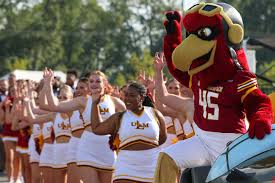Ever spotted a hawk sporting a bomber jacket? At the University of Louisiana at Monroe, that’s not a fashion choice—it’s a tradition. Say hello to Ace the UL-Monroe Warhawk, the flying, goggle-wearing bird who injects energy, school spirit, and history into every ULM game. From touchdowns to tailgates, Ace is more than a mascot—he’s an emblem of change, local heritage, and a people who know how to change and succeed.
What Is the UL-Monroe Warhawks’ Mascot?
Ace the Warhawk is not just some dude (or lady) dressed up in a costume—he’s the personality and fierce spirit behind ULM sports. Dressed in a bomber leather jacket, flying goggles, and that oh-so-confident swagger, Ace infuses spirit into the football games and community functions in Louisiana. He’s also got some wheels—the “Ace Mobile.” A customized golf cart that gets him rolling around campus on game days like a real mascot MVP.
But how did Ace get his start?
His flight plan began in 2006 when ULM was about to take flight into a new age. Before that, the university’s teams were called the “Indians,” a moniker they’d employed since 1931.
But in 2005, the NCAA clamped down on institutions employing Native American mascots and imagery, deeming them “hostile and abusive.” That left ULM with a difficult choice: abandon a longtime symbol or face sanctions that would affect recruiting, branding, and the overall game-day atmosphere.
ULM did not simply trade logos overnight. The school established a naming contest among the entire community, including students, alumni, and faculty submissions. Names spanned the range from “Bayou Gators” to “Thunderbirds.” But a single name took off above all else—”Warhawks.” It became the officially sanctioned name on June 26, 2006.
And that’s when it gets very fascinating. The name of the Warhawks wasn’t randomly generated either. It was selected in tribute to an American war hero: Lt. Col. Maj Gen. Claire Lee Chennault, a homeboy from Louisiana who commanded the legendary “Flying Tigers” throughout World War II. His pilots flew Curtiss P-40 fighter aircraft, which were—guess what—the Warhawks. That flight of fancy inspired Ace, ULM’s hawk mascot, the pilot’s attitude, and war lore baked right into his wings.
Now, Ace is an institution of ULM life. He goes to almost every high-profile university function, from games to student orientations, to hone his dance moves. He’s not there only for appearances—he’s on a mission. ULM’s official recreation site calls Ace a “living symbol of school spirit” and an “ambassador for the university.” And yes, he’s never too busy for a selfie.
Why Was the UL-Monroe Warhawks Mascot?
Let’s turn the clock back. ULM’s sports teams had been “the Indians” for decades, and the school even adopted a live mascot named Chief Brave Spirit during the 1980s. As sensitivity and talk about cultural appropriation increased, the NCAA started reassessing the use of Native American mascots. ULM joined the list of institutions forced to change or face postseason suspension and restrictive brand agreements.
That transition wasn’t painless. Most alumni had a strong affection for the previous identity, and the university sought to make the change with delicacy and deference. The governing committee saw over 300 proposed mascot name ideas and settled on twelve finalists. “Warhawks” hung on for two compelling reasons: it was original and allowed the university to highlight a regional legend in General Chennault.
KEEP READING: Georgia Southern Eagles Mascot History
Then, in 2006, there was a complete rebrand. New logos, fresh merchandise, and the Warhawk stole the spotlight. His look, from aviator goggles to cocky smile, was explicitly designed to emanate the power, bravery, and combativeness of ULM student-athletes and Louisiana’s rich military heritage.
“We knew we couldn’t just choose something cool; it had to be meaningful,” former athletic director Bobby Staub said. “Warhawks was the type of heritage we wanted to establish—feisty, respected, and connected to our heritage.”
And it paid off. Since he arrived on campus, Ace has gained a reputation as a fan favorite. He’s been seen assisting in charity drives, leading the cheers at homecoming, and even making surprise appearances at local schools to inspire future Warhawks. His status as the high-flying heart of ULM only increases.
Whether he’s getting the crowd pumped up on the sideline or riding around campus in his Ace Mobile, one thing’s certain: this bird’s heart—and a lot of history.
College Sports Network has you covered with the latest news, analysis, insights, and trending stories in football, men’s basketball, women’s basketball, and baseball!


